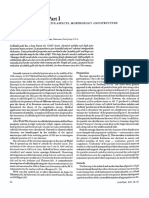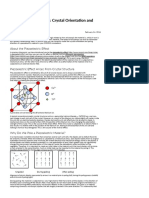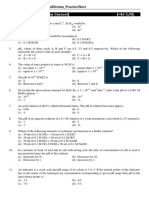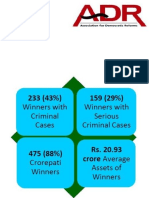Debereiner
Debereiner
Uploaded by
RSLCopyright:
Debereiner
Debereiner
Uploaded by
RSLOriginal Description:
Copyright
Share this document
Did you find this document useful?
Is this content inappropriate?
Copyright:
Debereiner
Debereiner
Uploaded by
RSLCopyright:
Johann Wolfgang Dobereiner
THE DISCOVERY OF CATALYSIS AND THE REFINING
OF RUSSIAN PLATINUM
By Donald McDonald
Johnson Matthey & Co Limited
Many of the most important contributors and, through his Theory of Triads, as a
to the progress of chemistry in the eighteenth pioneer of the Periodic System for classifying
and nineteenth centuries have intervened in the elements.
the story of platinum, fascinated by the Dobereiner was born the son of a Bavarian
extraordinary properties of the metal and the coachman and his education amounted to
difficulties of rendering it malleable and nothing very much. At the age of 14 he
fabricating it. For instance there was Baume, entered a pharmacy as apprentice and, after
who first introduced the idea of forging it like three years of that, practised as assistant at
iron, and Wollaston, who made a scientific several places including Karlsruhe, Bayreuth
business of this proposal. Another and later and Strasbourg. At the last he came into
one was the German chemist, J. W. contact with scientific men like Gmelin and
Dobereiner, best known as a great practical Bockmann, realised his educational short-
teacher, as a founder of the study of catalysis, comings and determined to overcome them.
Johann Wolfgang Dobereiner
1780-1849
Professor of Chemistry at Jena for
thirtynine years, a friend and prot6g.g
of Goethe. and the founder of the study of
catalysis. His discovwy of the power of
finely divided platinum to ignite a stream
of hydrogen caused a considerable stir
in chemical circles, and he was thefirst to
make use of what we now know as a
supported catalyst.
(From a portrait i n the City Museum
at Jena)
Platinum Metals Rev., 1965, 9 , (4),136-139 136
He could not afford a university course, but
assiduously attended lectures on chemistry,
mineralogy, botany and philosophy, while
trying to finance himself by means of three
entries into business, all of which ended
unfortunately. But in the meantime he had
begun to write on scientific subjects and had
attracted the attention of the well-known
editor-publishers Gehlen and Schweigger, so
much so that the former, in 1810, proposed
him for an Extraordinary Professorship of
Chemistry at the University of Jena.
Association with Goethe
Jena is twelve miles south-east of Weimar,
then the capital of the small, and at that time
independent, German state of Saxe-Weimar,
ruled by an hereditary prince with, after 1815,
the title of Grand Duke. From 1775 this
position was held by Karl August, a highly
intelligent patron of art, literature and
The Grand Duchess Maria Pavlovna
The daughter of Czar Paul I and the daughter-in-
science, and a supporter of the new liberal luw of Duke Kurt August won Weimur. Her
ideas that were beginning to creep into interest i n Dobereiner’s work on platinum com-
politics. bined with her connections with the Russian court
led to his being called upon to help in the refining
In order to forward these aims, he had of the platinum deposits that had recently been
appointed as his Minister of State no less a discovered i n the Urals
person than the young Goethe, who helped
him to attract to Weimar and Jena a remark- Alexander I and Nicholas I. The latter, who
able galaxy of intellectual talent. When in reached the Imperial rank at the end of 1825,
1810 Gehlen offered Dobereiner’s name to desired to develop the natural resources of
Karl August it was without much hope, as his Russia, and his principal agent in this
protege was not a graduate and had not even a activity was his very able Minister of Finance,
school certificate. But Karl August was Count Egor Kankrin. Kankrin, in his ex
satisfied with Gehlen’s recommendation and ojjicio capacity of Head of the Mining
saw that the candidate was given a doctorate Department, interested himself very deeply
at half the usual fee, paid, as the minutes in the discoveries of platinum deposits made
record, “in rather worn thalers”. It seems that in the Urals from 1824 onwards. This
Goethe approved of the appointment and material was already in demand in Western
Dobereiner became his chemical assistant. Europe for both decorative and scientific
Now the intellectual fame of Saxe-Weimar purposes but, as the basis for neither of these
had spread rapidly around Europe and attrac- was available in Russia, Kankrin, after con-
ted a flow of visitors, eager to partake in so sulting that great international authority
much that was new and progressive. They Alexander von Humboldt, had decided to
came from all over the continent and among use it for coinage. T o refine the native
them was the Grand Duchess Maria Pavlovna material for this purpose, he had com-
from Russia. She was a daughter of the Czar missioned the well-known Russian chemist
Paul I and was married to Karl August’s son; Sobolevsky to make the necessary arrange-
two of her brothers became the Czars ments and this had been done in the Govern-
Platinum Metals Rev., 1965, 9 , (4), 137
ment Mining Laboratory at St Petersburg.
But neither Kankrin nor Sobolevsky was
completely satisfied with the chemical
methods with which they had started their
operations and they were continually search-
ing for advice for improvement.
As it happened chemistry was one of the
interests of Maria Pavlovna and, through her
brother the Czar, she was well acquainted
with Kankrin’s work and his problem with
platinum. Similarly at Weimar, through her
father-in-law Karl August, she was aware
that Dobereiner had some experience in this
same field. As early in his career as 1812 he
had interested himself in refining some South
American native platinum in order to provide
himself with his own platinum apparatus and
she had obtained for him some further sup-
plies from Russia to help his work. Also, as
chemical advisor to the Minister of State, he
had to inspect the work of breweries and
distilleries and this led him to a long research
on the oxidation of alcohol and the possibility
of making vinegar from it by direct chemical
means.
One of many types of Dobereiner lamp i n which a
Experiments with Platinum Black jet of hydrogen, generated from zinc und dilute
sulphuric acid, i s ignited by a small amount of
In the course of all this work, he came Jnely divided platinum. ( B y eourtesy qf the Science
upon the experiment of Edmund Davy in Museum)
1820 on the power of chemically-reduced
platinum black to promote the oxidation of wrapped some of this in filter paper and
alcohol. He repeated this in 1821 and found demonstrated its use in gas analysis by ensur-
that not only did it oxidise the alcohol entirely ing the combination of oxygen and hydrogen
to acetic acid alone (without other less desir- in mixtures containing them and so producing
able products), but at the end the platinum easily measurable changes in volume. Finally
black remained unchanged and available on August 3rd, 1823, he showed that if
for more work, It therefore promised well platinum sponge is spread out on a watch-
for the direct production of vinegar from glass and a stream of hydrogen is directed on
alcohol. Before taking this further, however, to it in such a way that it mixes with air
DBbereiner made some further experiments before touching it, the gas bursts into flame
on platinum black, which he thought was a at once.
sub-oxide, and found that it absorbed large This discovery was very quickly developed
quantities of hydrogen and would then into the Dobereiner lamp, an instrument
“imbibe” oxygen until the former was all which, under suitable circumstances, replaced
oxidised to water. Then he turned his the tinder box as a means of lighting domestic
attention to that quite different form of lamps and candles, a function which it
platinum, the so-called sponge obtained by continued until it was replaced by the phos-
calcining ammonium chloroplatinate. He phorus match. It is interesting to note in
Platinum Metals Rev., 1965, 9 , (4), 138
passing that in 1832 Dobereiner discovered
the power of platinum to oxidise sulphur
dioxide to trioxide, but in this he had been
preceded by Peregrine Phillips in England a
year earlier. Also that he was the first to use
what we call today catalyst carriers. The
filter paper wrapping of 1823 was succeeded
by a dried and ignited mixture of platinum
sponge and potters’ clay; and an improved
version of the Dobereiner lamp had its
platinum sponge applied in an adhesive
coating on a coil of platinum wire. A final
comment on Dobereiner’s work on platinum
is that his process for the direct production
of vinegar was never used, because it was
overtaken by a more convenient indirect one!
But undoubtedly he occasioned a profound
interest in this new phenomenon, to which
Berzelius, the master of chemical nomen-
clature, gave the name “catalysis” in 1835.
So it is evident that Maria Pavlovna must
have found a great deal to interest her in
Dobereiner’s laboratory and no doubt she
reported it to Kankrin on her rcturn to St The title page of DGbereiner’s book on the chemistry
Petersburg, presumably somewhere in the of platinum
1830s. It is evident that he was pleased to be
in touch with the fresh mind of Dobereiner work of the English astronomer and chemist,
and moved at once to take advantage of it. Sir J. F. W. Herschel, in 1830 had clarified
Accommodation was arranged in Professor the subject considerably by showing that the
Osann’s chemical laboratory at the University lime will certainly precipitate the base metals
of Dorpat (now Tartu) and the services of a and the rhodium and iridium, but will leave
Dr Friederich Weiss of that University the platinum in the solution as long as it is
engaged. Dobereiner himself was of course not warmed or exposed to strong light. It
unable to leave Jena for any long period, so was upon this that Weiss and Dobereiner
his son, Franz Dobereiner, was sent to Dorpat based their improved process for the Russian
to work with Weiss and to be the agent for refinery. It was brought into use there after
full communication with Jena. Unlimited Sobolevsky’s death in 1841 and presumably
raw material was of course at their disposal continued until 1846, when the refinery was
and, no doubt, full access to the refining closed on the cessation of coining.
operations at St Petersburg. Their approach As far as is known, J. W. Dobereiner made
to the problem was by way of an attempt to no further contact with platinum after this,
free the solution of the native platinum in but maintained his distinguished teaching
aqua regia from iron and copper by the career until his death on March 24th, 1849.
addition of alkalies. This idea had been tried But among his many publications was a small
by earlier refiners without much success. book of a hundred pages on the history and
Chabaneau had got himself into difficulties properties of platinum, published in Stuttgart
by using milk of lime for the purpose in in 1836, which was remarkably comprehcn-
Madrid in the 1790s. But meanwhile the sive for its time.
Platinum Metals Rev., 1965, 9 , (4), 139
You might also like
- GRADE 9 PRE-TEST IN Consumer CHEMISTRYDocument2 pagesGRADE 9 PRE-TEST IN Consumer CHEMISTRYBreeza Marie VeralloNo ratings yet
- Atestat EnglezaDocument8 pagesAtestat EnglezaAnca Şi AdiNo ratings yet
- The Scientific Detection of Fakes and ForgeriesDocument8 pagesThe Scientific Detection of Fakes and ForgeriesAantchuNo ratings yet
- A Short History of Ferroelectricity PDFDocument9 pagesA Short History of Ferroelectricity PDFZuir HakizNo ratings yet
- (Ref - Platinum's Refractory Nature Towards Borax) William Brownrigg and His Scientific WorkDocument4 pages(Ref - Platinum's Refractory Nature Towards Borax) William Brownrigg and His Scientific WorkNones NoneachNo ratings yet
- The First Organometallic CompoundsDocument8 pagesThe First Organometallic CompoundsCamila Cabarcas HerreraNo ratings yet
- Acido Fulminico e A Historia Da Quimica OrganicaDocument7 pagesAcido Fulminico e A Historia Da Quimica OrganicaJaime CedranNo ratings yet
- Henri Sainte-Claire DevilleDocument8 pagesHenri Sainte-Claire DevilleCharles JacobNo ratings yet
- OxygenDocument6 pagesOxygenSrijay SutarNo ratings yet
- Eco9406 8228Document4 pagesEco9406 8228HariyadiNo ratings yet
- History of PhotographyDocument3 pagesHistory of Photographyenrico santosNo ratings yet
- The Chemical History of a Candle (Barnes & Noble Library of Essential Reading)From EverandThe Chemical History of a Candle (Barnes & Noble Library of Essential Reading)No ratings yet
- General Types of CatalysisDocument59 pagesGeneral Types of CatalysisMahmoud Galal Zidan FaragNo ratings yet
- Soc2677 3314Document4 pagesSoc2677 3314Niño Christian Joseph MasongNo ratings yet
- Michael FaradayDocument3 pagesMichael FaradayGaldinoNo ratings yet
- Ing QuimicoDocument6 pagesIng Quimicoalan moranNo ratings yet
- Chem1346 4916Document4 pagesChem1346 4916Jhan Ferdie LlagasNo ratings yet
- Leyden & Stockholm PapyriDocument117 pagesLeyden & Stockholm PapyriSubliminalNo ratings yet
- Ebooks File True Colors World Masters of Natural Dyes and Pigments 2nd Edition Keith Recker All ChaptersDocument34 pagesEbooks File True Colors World Masters of Natural Dyes and Pigments 2nd Edition Keith Recker All ChaptersjaisirdukatNo ratings yet
- Short Treatise On Iron Salts FragmentsDocument28 pagesShort Treatise On Iron Salts FragmentsJean-Claude MouginNo ratings yet
- Michael Faraday BiographyDocument2 pagesMichael Faraday BiographyMainak Singha BarmaNo ratings yet
- Dolan Embodied Skills2003Document27 pagesDolan Embodied Skills2003Sima Sorin MihailNo ratings yet
- FaradayDocument2 pagesFaradaynazkasihNo ratings yet
- Consolations in Travel; or, the Last Days of a PhilosopherFrom EverandConsolations in Travel; or, the Last Days of a PhilosopherNo ratings yet
- The Chemical History of a Candle (Barnes & Noble Digital Library)From EverandThe Chemical History of a Candle (Barnes & Noble Digital Library)No ratings yet
- Rembrandt's Chemist. A.P. Laurie and The Public Science of ArtDocument7 pagesRembrandt's Chemist. A.P. Laurie and The Public Science of ArtBictor BoulnoisNo ratings yet
- Acc9500 2284Document4 pagesAcc9500 2284Noodles CaptNo ratings yet
- Johann Wolfgang DöbereinerDocument11 pagesJohann Wolfgang DöbereinerFarhan YaminNo ratings yet
- Stoeckmann H-J 2007 Chladni Meets NapoleonDocument8 pagesStoeckmann H-J 2007 Chladni Meets NapoleonFrane DuiloNo ratings yet
- All That Glitters Fool S Gold in The EarDocument5 pagesAll That Glitters Fool S Gold in The Earpioggia66No ratings yet
- Bayer PaperDocument5 pagesBayer PaperMatt SalinovichNo ratings yet
- Chemical CompoundsDocument6 pagesChemical CompoundsOmkar DeshpandeNo ratings yet
- Group 3 Presentation Michael Faraday and His Contributions in The Field of Elctricity and ElectromagnetismDocument31 pagesGroup 3 Presentation Michael Faraday and His Contributions in The Field of Elctricity and ElectromagnetismIvan Salvador PapyrusNo ratings yet
- 1926 RADCLIFFE (TR.) The Leyden Papyrus XDocument18 pages1926 RADCLIFFE (TR.) The Leyden Papyrus XDannieCaesarNo ratings yet
- Antimony PDFDocument225 pagesAntimony PDFtripasca100% (1)
- Ebook Ib Psychology Course Book Oxford Ib Diploma Programme 2Nd Edition Alexey Popov Online PDF All ChapterDocument24 pagesEbook Ib Psychology Course Book Oxford Ib Diploma Programme 2Nd Edition Alexey Popov Online PDF All Chapterfred.bennett184100% (9)
- Dalton, John: Observations and Essays. He Then Became Interested in Preparing Collections of BotanicalDocument3 pagesDalton, John: Observations and Essays. He Then Became Interested in Preparing Collections of BotanicalProfessor Stephen D. WanerNo ratings yet
- The Early History of CatalysisDocument6 pagesThe Early History of Catalysisayechelle AquinoNo ratings yet
- John Canton - A BiopicDocument6 pagesJohn Canton - A BiopicgooliNo ratings yet
- Encyclopedia of Radicals in Chemistry Biology and Materials With Bookmark 1st Edition Chryssostomos Chatgilialoglu Armido StuderDocument70 pagesEncyclopedia of Radicals in Chemistry Biology and Materials With Bookmark 1st Edition Chryssostomos Chatgilialoglu Armido Studermildred.taylor539100% (19)
- Moore 1921Document53 pagesMoore 1921Cristina Spolti LorenzettiNo ratings yet
- Doppler Sonography: A Brief History: Christian Andreas Doppler and The Doppler TheoryDocument7 pagesDoppler Sonography: A Brief History: Christian Andreas Doppler and The Doppler TheoryFranklin Salirrosas CernaNo ratings yet
- Eng7589 1107Document4 pagesEng7589 1107falenixyNo ratings yet
- Biografia de Alfred NDocument3 pagesBiografia de Alfred NYaRe AvilaNo ratings yet
- Biografia de Alfred NDocument3 pagesBiografia de Alfred NYaRe AvilaNo ratings yet
- Perspectives: Alfred Nobel - His Life and WorkDocument6 pagesPerspectives: Alfred Nobel - His Life and Workblue nnnNo ratings yet
- Science4565 293Document4 pagesScience4565 293Juan Alcazar RomeroNo ratings yet
- Tài Liệu Không Có Tiêu ĐềDocument7 pagesTài Liệu Không Có Tiêu ĐềTâm Nguyễn Ngọc ThanhNo ratings yet
- Michael Faraday - Wikipedia, The Free EncyclopediaDocument14 pagesMichael Faraday - Wikipedia, The Free Encyclopediasharathr22100% (1)
- Eng11697521 8308Document5 pagesEng11697521 8308Anne LaneNo ratings yet
- Cosmos AlternativoDocument467 pagesCosmos AlternativoLeandro DiademiNo ratings yet
- AlchemicalManuscriptSeriesV13 PDFDocument309 pagesAlchemicalManuscriptSeriesV13 PDFzoroNo ratings yet
- Math6784 5824Document4 pagesMath6784 5824BALIONG, Lady Lee P.No ratings yet
- Em17 2253Document4 pagesEm17 2253Arjelyn MonteroNo ratings yet
- Eng1250 4718Document4 pagesEng1250 4718Annisa AthayaNo ratings yet
- Notes and Queries, Number 221, January 21, 1854 A Medium of Inter-communication for Literary Men, Artists, Antiquaries, Genealogists, etcFrom EverandNotes and Queries, Number 221, January 21, 1854 A Medium of Inter-communication for Literary Men, Artists, Antiquaries, Genealogists, etcNo ratings yet
- Mechanism of Organic ReactionDocument4 pagesMechanism of Organic ReactionRSLNo ratings yet
- S-Block Elments: Inorganic ChemistryDocument8 pagesS-Block Elments: Inorganic ChemistryRSLNo ratings yet
- Carbon Monoxide or Carbonyl: MO DescriptionDocument3 pagesCarbon Monoxide or Carbonyl: MO DescriptionRSLNo ratings yet
- Coordination Isomers ListDocument1 pageCoordination Isomers ListRSLNo ratings yet
- Epoxides Ring-Opening - Chemistry LibreTextsDocument3 pagesEpoxides Ring-Opening - Chemistry LibreTextsRSLNo ratings yet
- NH4BH4Document1 pageNH4BH4RSLNo ratings yet
- Colloidal Gold. Part I: Historical and Preparative Aspects, Morphology and StructureDocument6 pagesColloidal Gold. Part I: Historical and Preparative Aspects, Morphology and StructureRSL100% (1)
- Basics of ElectrochemistryDocument22 pagesBasics of ElectrochemistryRSLNo ratings yet
- Turkevich1985 Article ColloidalGoldPartII PDFDocument7 pagesTurkevich1985 Article ColloidalGoldPartII PDFRSLNo ratings yet
- Redox Reactions and Balancing Using Oxidation Number & NfactorDocument1 pageRedox Reactions and Balancing Using Oxidation Number & NfactorRSLNo ratings yet
- Colloids: Thomas Graham (1861) Studied The Ability of Dissolved Substances ToDocument28 pagesColloids: Thomas Graham (1861) Studied The Ability of Dissolved Substances ToRSLNo ratings yet
- © 1934 Nature Publishing GroupDocument2 pages© 1934 Nature Publishing GroupRSLNo ratings yet
- Piezoelectric Materials: Crystal Orientation and Poling Direction - COMSOL Blog PDFDocument4 pagesPiezoelectric Materials: Crystal Orientation and Poling Direction - COMSOL Blog PDFRSLNo ratings yet
- List of Straight-Chain AlkanesDocument6 pagesList of Straight-Chain AlkanesRSLNo ratings yet
- Priority List IUPACDocument1 pagePriority List IUPACRSLNo ratings yet
- 2019dec-03 - Ionic Equilibrium - PracticeSheetDocument2 pages2019dec-03 - Ionic Equilibrium - PracticeSheetRSLNo ratings yet
- Analysis Report of Criminal and Financial Background Details of Winners in Lok Sabha 2019 ElectionsDocument397 pagesAnalysis Report of Criminal and Financial Background Details of Winners in Lok Sabha 2019 ElectionsRSLNo ratings yet
- Isoelectric Point, PiDocument2 pagesIsoelectric Point, PiRSLNo ratings yet
- Colligative Properties: Cryoscopy & EbulliosDocument30 pagesColligative Properties: Cryoscopy & EbulliosRSL100% (1)
- EAS Worksheet 1 SubjDocument1 pageEAS Worksheet 1 SubjRSLNo ratings yet
- Chemistry Organic GOC Reaction Mechanism Elimination E1 E2 E1cBDocument4 pagesChemistry Organic GOC Reaction Mechanism Elimination E1 E2 E1cBRSL100% (1)
- Ionic Equilibrium - Salt Hydrolysis Practice Questions (Level-1)Document3 pagesIonic Equilibrium - Salt Hydrolysis Practice Questions (Level-1)RSLNo ratings yet
- Factors Affecting Relative Strengths of Acids and BasesDocument1 pageFactors Affecting Relative Strengths of Acids and BasesRSL80% (5)
- Koopmans TheoremDocument14 pagesKoopmans TheoremRSLNo ratings yet
- Crossword Coordination CompoundsDocument2 pagesCrossword Coordination CompoundsRSLNo ratings yet
- The World of Chemistry Episode 5 - A Matter of StateDocument2 pagesThe World of Chemistry Episode 5 - A Matter of StateRSL0% (1)
- Leading and Lagging Strand NotesDocument3 pagesLeading and Lagging Strand NotesAmiera AmaniNo ratings yet
- Gen - Bio1: Quarter 1 - Module 1: Title: Structural Components of The Cell MembraneDocument23 pagesGen - Bio1: Quarter 1 - Module 1: Title: Structural Components of The Cell MembraneRea A. Bilan100% (7)
- Melc No. 3: Explain How Ions Are Formed (S9Mt-Iie-F-16) : Alkaline Earth Metals Non-Metals ActinidesDocument11 pagesMelc No. 3: Explain How Ions Are Formed (S9Mt-Iie-F-16) : Alkaline Earth Metals Non-Metals ActinidesAira RamirezNo ratings yet
- Phys 805Document4 pagesPhys 805ChanNo ratings yet
- Chemthink - Molecular ShapesDocument3 pagesChemthink - Molecular Shapesanthonye0878No ratings yet
- Lecture 5-The Vanadium GroupDocument38 pagesLecture 5-The Vanadium Groupmalenya1No ratings yet
- Experimental Investigation and Computational Modelling of The Thermoforming Process of Thermoplastic StarchDocument152 pagesExperimental Investigation and Computational Modelling of The Thermoforming Process of Thermoplastic StarchLya Deliazee SyufaNo ratings yet
- Recent Patents On EngineeringDocument67 pagesRecent Patents On EngineeringmarcomtnNo ratings yet
- Physio Ex Exercise 8 Lab ReportDocument4 pagesPhysio Ex Exercise 8 Lab ReportDevina Afraditya PavetaNo ratings yet
- Pcos LecDocument14 pagesPcos LecsherilleNo ratings yet
- Ion ExchangeDocument66 pagesIon ExchangeTsebe HermanNo ratings yet
- ChromiteDocument29 pagesChromiteVijay Chander Reddy Keesara100% (4)
- Synthesis of Aspirin DataDocument3 pagesSynthesis of Aspirin DataAnonymous orNHXM0f0No ratings yet
- Non Aqueous Titrations by Gunja ChtaurvediDocument10 pagesNon Aqueous Titrations by Gunja ChtaurvediGunja Chaturvedi88% (8)
- Project Sample Literature ReviewDocument0 pagesProject Sample Literature Reviewapi-94846453No ratings yet
- S.V. Sysolyatin Et Al - Synthesis of Polycyclic Nitramines by Nitration of Condensation Products of Glyoxal and Formaldehyde With Sulfamic AcidsDocument11 pagesS.V. Sysolyatin Et Al - Synthesis of Polycyclic Nitramines by Nitration of Condensation Products of Glyoxal and Formaldehyde With Sulfamic AcidsKommissar1981No ratings yet
- Chapter 1 - Introduction To Materials ScienceDocument40 pagesChapter 1 - Introduction To Materials Sciencetjipotjipi mungundaNo ratings yet
- Ebook Pocket Guide Geology in The Field Mccann Online PDF All ChapterDocument69 pagesEbook Pocket Guide Geology in The Field Mccann Online PDF All Chapteramanda.eisenberg545100% (12)
- Fire SafetyDocument36 pagesFire SafetyDembelo DagimNo ratings yet
- Redox Reaction PDFDocument12 pagesRedox Reaction PDFErsan ResurreccionNo ratings yet
- Lab 22Document2 pagesLab 22Webber128No ratings yet
- Coating Strategies For Atomic Layer Deposition: Liang Hu, Weihong Qi and Yejun LiDocument22 pagesCoating Strategies For Atomic Layer Deposition: Liang Hu, Weihong Qi and Yejun LitehtnicaNo ratings yet
- Composition and Grades of Cast IronDocument5 pagesComposition and Grades of Cast IronahmedNo ratings yet
- Webinar Compounding-103 Smithers-Rapra 2-27-2019Document43 pagesWebinar Compounding-103 Smithers-Rapra 2-27-2019cuenta_descarga88100% (1)
- Concentration of Solutions NotesDocument5 pagesConcentration of Solutions NotesIonacer ViperNo ratings yet
- Cpi Notes For MidtermDocument30 pagesCpi Notes For MidtermMolAD34 VinceDapanasNo ratings yet
- SyllabusDocument107 pagesSyllabusrajeshNo ratings yet
- Media Preparation and Uses in Medical MicrobiologyDocument20 pagesMedia Preparation and Uses in Medical MicrobiologyPrincewill SeiyefaNo ratings yet
- Topical AgentsDocument5 pagesTopical AgentsFemina Argonza100% (1)



















































































































